UMPC Update:
What's Happened Since the March 9, 2006 Launch?
by Geoff Walker, 5/2/06
(Initially appeared in the Touch Panel Newsletter by Veritas et Visus)
Eight weeks ago Microsoft launched the Ultra-Mobile PC (UMPC) after an unusually successful viral marketing campaign. The Touch Panel covered the launch with an extensive analysis of the product and market (see issue #4). This article describes what's happened in the UMPC world since the launch.
Analyst Reactions: Gartner was the first to chime in on March 14th with a Research Note entitled "UMPC has promise but Is Far from Mature". Gartner believes that the UMPC concept has promise in the consumer market as a "lifestyle device" acting as a notebook auxiliary or replacement. While Gartner understands that a key element of the UMPC's value proposition is its positioning as a new lifestyle category, they believe that the device manufacturers don't understand that aspect, viewing it instead as just another new hardware form factor. In order for the UMPC to achieve success, Gartner believes that the following improvements are necessary:
- Eight-hour battery life
- $400 price
- Low-cost, compelling content bundles
- A better Microsoft user interface running on top of Vista
- Text-entry options beyond "thumb-typing"
- Automatic data synchronization
- Sustained market momentum from Microsoft and Intel
Gartner believes that the UMPC was rushed to market before it's ready to succeed. For this reason they assign a probability of 80% to the UMPC not achieving mainstream success (sales in the millions of units) by 2009.
Representing the other extreme, In-Stat released a research report on April 26th entitled "The In-Stant Analysis: The Ultra-Mobile PC - Hip or Hype?" Their conclusion is that it's the former. In-Stat believes that the potential for UMPC shipments could be as high as 7.8M units by 2011. In-Stat's press release on the report was entitled "New Personal Computing Segment Poised for Strong Growth", which qualifies their outlook. Interestingly, different media outlets and blogs put different slants on the 7.8M-unit number. Some viewed the number as strongly positive results for a new mobile computer product category (IT-thinking); others viewed the number as weak performance when viewed in the context of the size of the potential consumer market (CE-thinking).
In the middle ground is a well-written think-piece on the Knowledge@Wharton (University of Pennsylvania business school) website that pulls together a number of thoughts and opinions by Wharton professors and technology directors. The key message in the piece is as follows:
"No matter how the UMPC fares, it could turn out to be a worthwhile experiment for Microsoft, which can afford to tackle new markets with the UMPC and Xbox 360 video game console because it had $34.7 billion in cash and short-term investments as of December 31, 2005. In some ways it's not atypical of Microsoft to invest a lot in a technology that may not deliver an immediate return - [for example,] it has been pouring resources into the Xbox for quite a while. Microsoft's UMPC effort may not need to be a short-term financial success to be a long-term winner. To propagate its software, Microsoft has to have some control over hardware. Eventually there will be one portable device that is more user-friendly than a cell phone masquerading as a computer."
Shipping Products: TabletKiosk had proclaimed that they would be the first to ship actual UMPCs in the USA, and then at the last minute they had a manufacturing glitch. On April 24th they issued a press release that described the problem, as follows: "There was an issue in the tooling of the back panel that affected the operation of the system fan. Because of this problem, the back panel had to undergo a slight redesign and thus the initial shipment is going to be only a fraction of what we had anticipated. Additionally, we expect the supply of the product to be extremely tight for the next 60 to 90 days as the production supply catches up to demand."
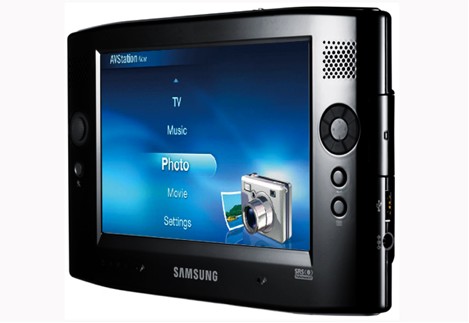 As a result, the Samsung Q1 (Figure 1) turned out to be the first UMPC to reach the USA (worldwide rollout started May 1st). However, not everything went smoothly for Samsung either. At the mid-April launch press conference for the Q1 in Seoul, Korea, the demo gods struck with a vengeance. Samsung VPs experienced the following during their attempt to demo the Q1: (1) an inability to start the PowerPoint presentation (stored in the Q1), (2) an inability to advance to the second slide, (3) a dead battery after showing several slides, and (4) the Q1 flipping through all the presentation slides in just a few seconds. At the press conference, Samsung stated that the sales goal for the first 12 months was 100,000 units in Korea and 300,000 units worldwide. As a result, the Samsung Q1 (Figure 1) turned out to be the first UMPC to reach the USA (worldwide rollout started May 1st). However, not everything went smoothly for Samsung either. At the mid-April launch press conference for the Q1 in Seoul, Korea, the demo gods struck with a vengeance. Samsung VPs experienced the following during their attempt to demo the Q1: (1) an inability to start the PowerPoint presentation (stored in the Q1), (2) an inability to advance to the second slide, (3) a dead battery after showing several slides, and (4) the Q1 flipping through all the presentation slides in just a few seconds. At the press conference, Samsung stated that the sales goal for the first 12 months was 100,000 units in Korea and 300,000 units worldwide.
Reviews of the Q1 have appeared in several media outlets, including PC Magazine, Personal Computer World, MSNBC and (of course) quite a few UMPC enthusiast websites and blogs. The reviews in the conventional media range from negative to neutral, depending on the perspective of the publication. For example, PC Magazine's reviewer characterizes the Q1 as follows:
- "[The Q1] is just another slate tablet that can't replace a true PC, but it makes for a nice portable media player that would be more attractive if it weren't so pricey."
- "I feel that the UMPC idea is just another questionable attempt by Bill Gates to revive the slate tablet."
- "I appreciate the design, and the technologies that can be had in such a small unit, but the practicality of this device escapes me. For $1,099, you're better off with a more capable - and keyboard-equipped - convertible Tablet PC."
One fairly universal comment is that the Q1 is appealing as a portable media player (PMP). The screen is bright and sharp, and large enough for comfortable viewing. However, dedicated-purpose PMPs such as the Archos AV700 are available with similar-sized screens and better PVR (personal video recorder) functionality for less than half the price ($450).
Many of the reviews include fairly legitimate complaints about hardware characteristics of the Q1, such as the following:
- Vertical viewing angles are a problem, just like on a Tablet PC with a standard (non-Hydis wide-angle) screen
- Battery life is too short - most reviewers seemed to get around 2.5 hours with light use, and around 1.5 hours while watching a DVD
- There's no bridge battery, so before switching to a new battery pack, the Q1 must be shut down and then rebooted after the new battery pack is installed
- Performance is generally sluggish
New UMPCs Announced: Five new UMPCs have been announced during the past eight weeks. However, these five new UMPCs don't actually include any truly "new" products. They consist of two existing ODM products (self-branded products from the actual manufacturer of one or more announced OEM's products) and three OEM-branded version of those ODMs' products. The five products include the following:
- Elitegroup Computer Systems (ECS) "H70": Founder's (and now Daewoo's, see below) UMPCs are manufactured by ECS, a Taiwanese ODM. ECS' self-branded version of their UMPC, the H70, was actually announced at CeBIT 2006 but received practically zero press coverage. Oddly, ECS had a press release about the H70 on their website at CeBIT time, but the press release is now gone. The product is definitely headed for production, however, since it just received FCC approval (interesting documentation and internal photos are available on the FCC website). ECS had previously developed a Transmeta-based 8.4" Tablet PC, model EZ30, but they were never able to find an OEM customer for it - they seem to be having better luck with the H70.
- Daewoo Lucoms "Solo M1": This is an OEM-branded version of the ECS H70 (see Figure 2). It is almost identical to Founder's Mini-Note version of the same ODM product, except for the substitution of a Celeron M for the Mini-Note's Pentium-M. This product will be sold only in the Korean market.
- AMtek "T700": Amtek is a Taiwanese Tablet PC ODM who has expanded into the UMPC market. Their UMPC (see Figure 3) is resold by TabletKiosk in the USA as the "eo", by PaceBlade in Japan (PBJ) as the "Smart Caddie", by PaceBlade in The Netherlands as the "EasyBook P7" (see below), and by It's Label in France as the "Origami" (see below). At the time of the Microsoft UMPC launch, Amtek wasn't ready to launch their self-branded version of the T700, but now they've had time to launch it.
- PaceBlade EasyBook "P7": This is another OEM-branded version of the Amtek T700 UMPC (see Figure 4). It is basically the European version of the PaceBlade Japan (PBJ) SmartCaddie.
- It's Label "Origami": This is another OEM-branded version of the Amtek T700 UMPC (see Figure 5). The specs appear identical to the T700. This product will be sold only in the French market. The price in France is 990 Euros, or about $1,250. The identically configured model from TabletKiosk in the USA is $1,000.
Note the total absence so far of any big-name notebook or Tablet PC OEMs - HP/Compaq, Toshiba, IBM/Lenovo, Gateway, Dell, etc. It's still unclear if this is by (Microsoft's) design, or if it's because of the nature of the product and its target market.
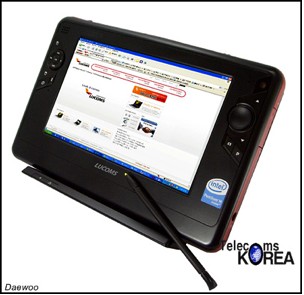
Figure 2: Daewoo Lucoms Solo M1 UMPC
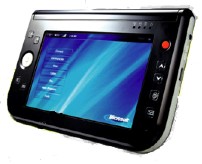
Figure 3: Amtek T700 UMPC
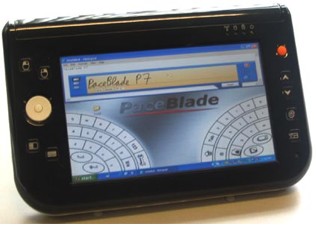
Figure 4: PaceBlade EasyBook P7
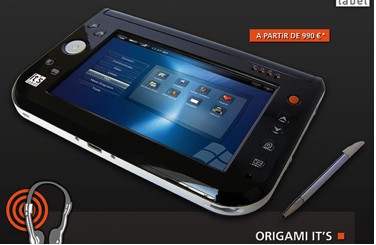
Figure 5: It's Label Origami UMPC
Table 1: All announced UMPCs as of May 3, 2006
(** Product not on company website yet - see the enthusiast sites for product information)
Concept UMPCs Announced: At part of a Japanese Design exhibition at a design show in Milan (Italy) at the beginning of April, Fujitsu showed a concept model of a new form-factor for a UMPC with a fold-out, double-sided keyboard. A few weeks before, DigiTimes reported that Fujitsu is currently in talks with Microsoft for possible launch of UMPC products. The Director of Product Marketing and Communications for Fujitsu PC Asia-Pacific said that since a UMPC is considered more like a high-end PDA than a notebook, their sales will hardly threaten Fujitsu's current 8-inch notebook offerings. The concept models aren't completely consistent with the Director's statement, which, given the size of Fujitsu, isn't surprising.
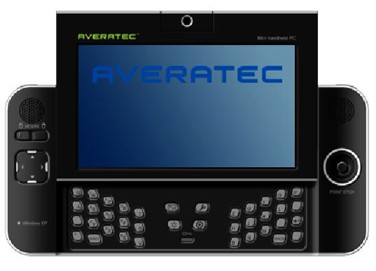 Averatec announced (or leaked - it's unclear) some information on their AHI "almost-UMPC" concept (see Figures 6). It's an "almost-UMPC" because Averatec says its runs Windows XP Home rather than XP Tablet. All the other specs appear to be consistent with the UMPC standard. The LCD is a 5" wide-aspect screen. Averatec's information says that it's an "SXGA" display without specifying any pixel format. That's extremely unlikely, since SXGA (1280x1024, a 5:4 aspect ratio) is normally found only in monitors. The screen in the photo of the CGI mockup (Figure 8) is clearly wide-aspect. Measuring it with an on-screen pixel ruler yields an aspect ratio of 1.75:1, very close to the standard wide aspect ratio of 1.67:1. Since the photo is probably of a mockup, the difference may be irrelevant. The actual pixel format of the screen is unknown, but the most likely configuration is 800x480 (WVGA), the same as all other UMPCs to date. However, because it's a 5-inch screen, the pixel density would be 186 - considerably higher than the 133 PPI of the standard 7-inch UMPC screen. Averatec announced (or leaked - it's unclear) some information on their AHI "almost-UMPC" concept (see Figures 6). It's an "almost-UMPC" because Averatec says its runs Windows XP Home rather than XP Tablet. All the other specs appear to be consistent with the UMPC standard. The LCD is a 5" wide-aspect screen. Averatec's information says that it's an "SXGA" display without specifying any pixel format. That's extremely unlikely, since SXGA (1280x1024, a 5:4 aspect ratio) is normally found only in monitors. The screen in the photo of the CGI mockup (Figure 8) is clearly wide-aspect. Measuring it with an on-screen pixel ruler yields an aspect ratio of 1.75:1, very close to the standard wide aspect ratio of 1.67:1. Since the photo is probably of a mockup, the difference may be irrelevant. The actual pixel format of the screen is unknown, but the most likely configuration is 800x480 (WVGA), the same as all other UMPCs to date. However, because it's a 5-inch screen, the pixel density would be 186 - considerably higher than the 133 PPI of the standard 7-inch UMPC screen.
The size of the AHI is 7.3" x 3.5" x 1.3", which is about 68% of the volume of the average UMPC. The most interesting feature of the AHI is the sliding screen that covers a small keyboard. Pricing was estimated by Averatec to be between $625 and $1,125 (converted from Euros), depending on the configuration. Availability is planned for Christmas 2006.
Future Products: One of the most interesting future product announcements made recently is that Samsung's next UMPC (due out at the end of 2006) will use a VIA processor and will be priced at "slightly over $700". This would be a very large price reduction over the $1,100 price of the Intel-based Samsung Q1 ($1,264 in Korea), and a moderate price reduction over the $900 price of the VIA-based TabletKiosk eo. This story appeared in both the Taiwan Economic News and Korea Telecoms, so there may be some truth to it. It's particularly significant because it marks VIA's potential comeback to the microprocessor market after being pushed out of the market by Intel's Pentium patent lawsuits. According to VIA, its low-power processor and embedded chipset now account for 25%-30% of VIA's revenue.
Another future UMPC is the "BoBos" device from Mobits. Mobits confirmed to OrigamiPortal.com via email that they are developing both 7-inch and 5.6-inch Origami products. Mobitia is a Taiwanese ODM, so these aren't real products yet. They won't become real products until Mobitia finds an OEM customer who is willing to buy them - that is, pay for tooling and production. Mobitia's website is so primitive that there's not even a decent image of the BoBos to grab for this article, so don't hold your breath for this one!
Microsoft and Intel: Microsoft's major effort on the UMPC was pre-launch, so there's been relatively little Microsoft news since launch. However, there are four new items: (1) a UMPC tutorial, (2) the ISV (independent software vendor) Early Adopter Program, (3) the "I Love UMPC" contest, and (4) an updated price range for the UMPC. The tutorial consists of three short videos sized for the UMPC screen and totaling around 8 minutes; they're not bad but they're really more marketing pieces than true tutorials. And, so typical of Microsoft, the tutorials will play only in Internet Explorer, not in Firefox.
The ISV program currently includes the software companies and products listed in Table 2 below.
| Company |
Product Name |
Application Category |
| Adobe |
(Unspecified) |
Creative |
| Agilix |
GoBinder |
Student |
| Ambient Design |
ArtRage |
Drawing |
| Blackboard |
Academic Suite |
Education support |
| Corel |
Painter Essentials |
Drawing |
| Design Universe |
GoBinder (reseller) |
Student |
| DyKnow |
Vision & Monitor |
Education tools |
| FranklinCovey |
(Unspecified) |
Organizer |
| JumpingMinds |
InkGestures |
Utility |
| Mi Corporation |
Forms |
Utility |
| Mindjet |
MindManager |
Information management |
| Mobile Kinetics |
HandPortal |
"Lifestyle application" |
| Newspaper Direct |
(Unspecified) |
Electronic media |
| SAP |
(Unspecified) |
CRM |
| Think |
Calculator & MathJournal |
Education |
| Slingbox Media |
SlingPlayer |
Entertainment |
Table 2: Companies participating in Microsoft's ISV Early Adopter Program
The "I Love UMPC" contest consisted of Microsoft collecting essays from enthusiasts on "why you love the idea [of the UMPC] and what you plan to do with it". It's a clever way of gathering market feedback information. The first prize was five Samsung Q1s; the second prize was 10 UMPC T-shirts.
Finally, Microsoft updated the "official target UMPC price range" to reflect what the OEMs are actually doing. Originally it was $600 to $1,000; now it's $600 to $1,200.
Intel (as expected) was even less busy than Microsoft. The only new information available from Intel is three videos on potential UMPC vertical applications. The videos include the following markets and content:
- Healthcare: Standard patient-care activities, the same as has been done since 1998
- Government: An inspector of some kind on a construction site
- Education: Students taking notes and pictures on a field trip, then presenting the results
Vertical Markets: On a blog called "Medical Connectivity Consulting", the blog's author wrote the following observations about what he considers to be the reality of UMPCs in healthcare applications:
"Now that the initial flurry of stories about the new UMPCs is over, let's look at what it all might mean. These new devices are consumer-oriented devices; probably stealth digital rights management (DRM) platforms. To cut it as a platform for [healthcare] caregivers, they will need to be small enough to fit in a lab coat pocket, ruggedized enough to survive a waist-high drop onto linoleum, and water resistant so you can wipe off the inevitable patient fluids with disinfectant. Oh, and the enclosures will have to be made out of a material that is impervious to the deleterious effects of disinfectants, especially brittleness. The best things about the UMPCs are the screen size and the promise of a standard Windows platform. These devices will never replace a laptop or tablet for EMRs [electronic medical records], but they could easily take over applications now deployed on PDAs. The device that comes closest to healthcare requirements is still the OQO [www.oqo.com].
A different healthcare consulting company, Ducknet Services, expressed exactly the opposite opinion. In a detailed and well-illustrated post on their website entitled "Can a UMPC Be Use for [Patient] Charting?", Ducknet makes a fairly convincing argument that a UMPC can be substituted for a standard slate form-factor Tablet PC in EMR applications without any serious difficulty. Reality is probably somewhere between the two opinions.
Less-demanding vertical markets may be more of a shoe-in for the UMPC. For example, real estate assessment is a plausible application for a UMPC. In fact, Apex Software is already promoting their sketching and area calculation software on the TabletKiosk UMPC.
According to an article in Ziff Davis' Extreme Nano, Microsoft has actually confirmed that they do have enterprise plans for the UMPC. In the same article, Steve Baker, an analyst with NPD Group (who now owns DisplaySearch) said, "Almost all of these [new mobile computer] devices tend to find a home somewhere in some vertical application. The tablet is a great example of that, since casual users don't have much use for them, but developers in some verticals have found the right way to market to shipping companies, insurance adjusters and other remote workers."
Touch-Related Issues: As expected, UMPCs without palm rejection are creating immediate user frustration. For example, the reviewer at PC Magazine said the following about the Samsung Q1 (which uses a standard touch screen without palm rejection): "The Q1 is good for writing short e-mails without getting frustrated, but longer assignments are much harder, since, in practice, the side of my hand constantly hit the touch screen, causing the mouse cursor to fly off-target."
As described in the previous issue of Touch Panel, TabletKiosk intelligently used a touch screen from Taiwanese vendor Transtouch in the eo that does include palm rejection. One of the bloggers who managed to obtain an early TabletKiosk unit, Rob Bushway from GottaBeMobile.com, described testing two versions of the touch screen. His observations are as follows. (In the quote below, "80 grams" and "120 grams" refers to the amount of force required to activate the touch screen; higher numbers give better palm rejection.)
- "With the 120-gram [touch screen], you have to press fairly hard with your fingertip or by using your finger nail/stylus to activate the buttons. I don't have long fingernails, so I have to flip my hand over to use my fingernail. However, you get pretty decent ink performance with very little interference from your hand. I still experience some interference from my pinky, though. With the 80-gram [touch screen], though, all you have to do is gently touch the screen with the fleshly part of your finger- no fingernail or stylus needed. However, you will get a great deal of hand interference when you ink and your hand is on the screen. Personally, I will not buy an 80-gram UMPC."
One of Microsoft's key goals in the design of the UMPC was to make it easier to use Windows on a touch screen-equipped mobile computer. It's not clear that they actually succeeded. In fact, it's beginning to sound like a typical version 1.0 Microsoft product. Here are some of Rob Bushway's observations about the touch experience on the UMPC:
- "I'm disappointed in the whole touch experience, and not just due to the 80-gram touch screen. I expected a great deal out of the box and I just didn't feel like the experience delivered. The whole Program Launcher/Touch Pack just doesn't feel as integrated of an experience as say, Media Center. I honestly see it as a glorified set of folders with shortcuts. When you install something, it doesn't get added to the Program Launcher. You have to add it separately. In addition, the programs used to customize the launcher are just WinForms with difficult-to-navigate dropdowns - not good for touch. When you click on DialKeys in the Program Launcher, you get a message that DialKeys is already running, rather than it displaying the touch icon so you can use DialKeys. Little things like that spread throughout the experience just brought the whole thing down a couple of notches for me."
- "The alternates/correction part of the TIP [Tablet Input Panel] does not work well at all with the touch screen. It relies heavily on the hover capability [in electromagnetic digitizer-equipped standard Tablet PCs] to show the dropdown for different letter choices. That dropdown doesn't show up when using the stylus or mouse [due to the lack of hover in a resistive touch screen], and 99% of the time I can't get the alternate letters to appear."
What It All Means: The UMPC is business as usual for Microsoft. It's an experiment. The product is only one-third-baked (i.e., it's at Version 1.0), so it has a long way to go to meet expectations. Microsoft can afford to spend money on markets that may take a long time to produce a return, so it could take a while to determine if the product is going to survive or fold. Microsoft's ultimate goal is to get their software into every possible computing device category, and the UMPC is just one more category that may or may not actually exist.
For More Information on UMPCs: Listed below are 22 websites that are currently publishing information about UMPCs. The majority of them are enthusiast sites.
Parting Shot: As the closing photo in their review of the Samsung Q1, Personal Computer World (UK) offered the captioned photo below.
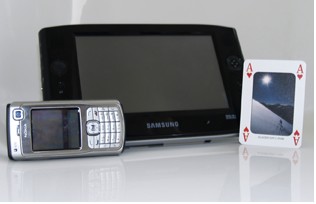
"The Q1's size and weight is its real selling point, but
is it something you'd want to carry around with you?"
Based in Silicon Valley, Geoff Walker is a
consultant with Walker Mobile, LLC (www.walkermobile.com).
Geoff has worked on the engineering and marketing of mobile computers since
1982 at GRiD Systems, Fujitsu Personal Systems (now Fujitsu Computer Systems)
and Handspring. In addition to mobile computers, Geoff's areas of particular
expertise include displays and digitizers.
|



